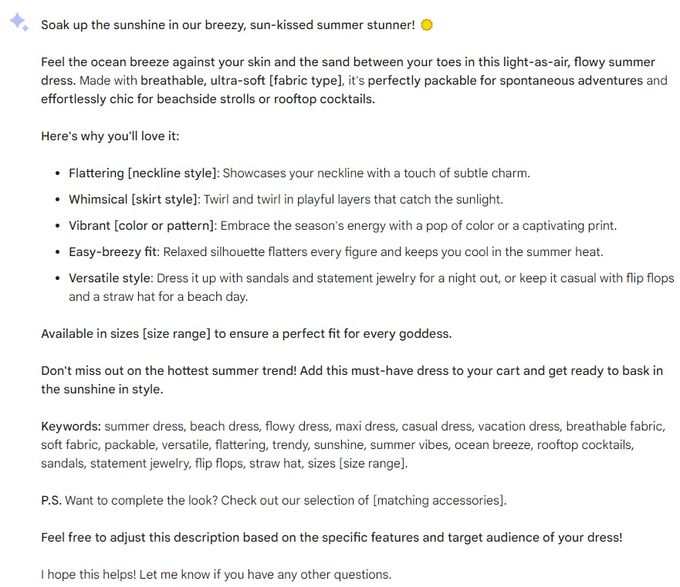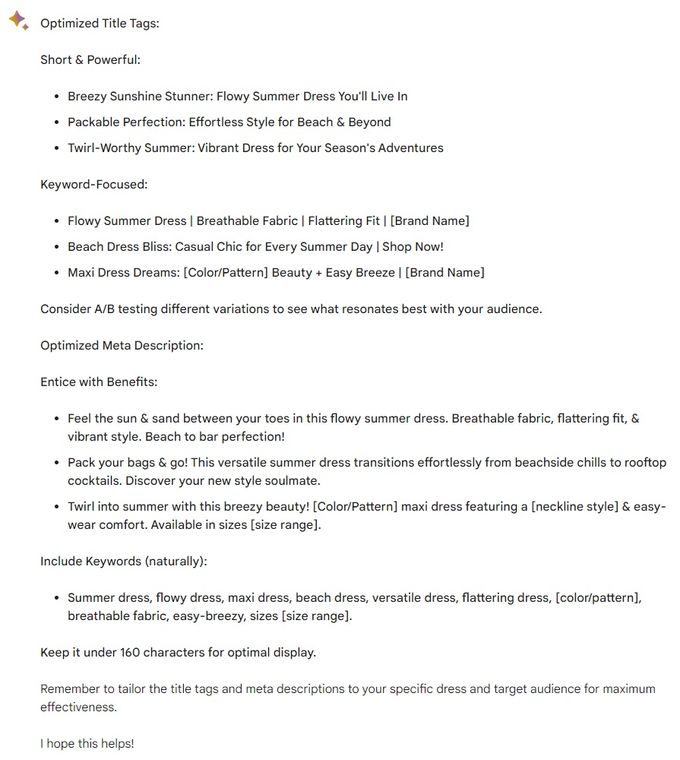Integrating Google Bard for Better Website Search Optimization
Using Google Bard for SEO can improve your online visibility. Create personalized content that drives traffic and engages your audience.
Updated November 19, 2024.

Did you know that optimizing your website's content for search engines is the key to eCommerce success? It's true: more than 70% of B2B revenue is generated through paid and organic search. By ranking higher in SERPs (search engine results pages), your eCommerce website becomes more visible to potential customers, increasing traffic, sales, and revenue. So, how can you improve your search engine ranking?
One of the answers lies in integrating Google Bard. This AI tool can help you optimize your content for search engines. Google Bard does this by analyzing factors like keywords, backlinks, and user experience. Here's how.
Meet the Expert
Jameela Ghann is a seasoned online store owner with over a decade of eCommerce experience. Apart from running Alora Boutique, she's also the marketing manager for Fera Product Reviews.
What Is Google Bard?
Google Bard is an AI chatbot designed to understand and respond to user queries conversationally. It leverages machine learning algorithms and neural networks to understand natural language, recognize patterns, and generate responses.
With its direct link to Google Search, Google Bard offers us immediate updates on search trends and algorithm changes. This allows us to make well-informed decisions that comply with Google's latest SEO guidelines.
Beyond automating standard tasks like keyword research and content optimization, Google Bard also enhances the user experience. It does this by customizing content suggestions and refining website interaction. This ensures a more personalized marketing approach for a better user experience.
» Looking for more ways to ensure a personalized and efficient user experience? Check out these benefits of personalized search for eCommerce merchants
How to Integrate Google Bard for Search Optimization
Generate Keyword-Rich Content
Google Bard can produce content rich in keywords for better product descriptions, blog posts, and category pages. This means it can generate specific words or phrases related to your products that potential customers will likely use when searching online. This higher keyword relevance can improve rankings.
Here's an example from Google Bard with the prompt, "Generate a keyword-rich product description for a summer dress":
Pro tip: Don't forget to edit all the copy generated by Google Bard. It can help give you an idea of the format and the kind of keywords you need to include, but Google doesn't like AI-generated content! Think of it as a good starting point that needs human intervention.
Optimize Title Tags and Meta Descriptions
An optimized title tag and meta description can help an eCommerce website improve its visibility, attract customers, and increase conversion rates.
Both critical SEO elements, Google Bard can optimize title tags and meta descriptions. In simple terms, title tags and meta descriptions are short pieces of text that summarize a page's content and appear in SERPs.
Here's an example from Google Bard with the prompt, "Please optimize the title tags and meta description for that summer dress' product page":
Pro tip: Just like Google Bard suggests, don't forget to use A/B testing to figure out the best approach for your business
Identify and Fix Technical SEO Issues
Technical SEO is optimizing your website to be crawled and indexed by search engines without problems. Google Bard can help identify and fix technical issues hindering this process.
It can check and rewrite schema markups and optimize your website’s URL structure, navigation, and internal linking. It can detect broken links, ensure your site is mobile-friendly, and check if it has a fast loading speed, among other things.
Using Bard can boost your webpage’s relevance and authority, saving time and energy. These are all important factors that search engines consider when ranking a website.
» Learn more about merchandising and its benefits
Keyword Gap Analysis
Keyword gap analysis is another area where the Bard showcases the power of chatbots. It can analyze the website's content and identify gaps where certain keywords important for the business' industry are not being used.
Once the gaps are identified, blog posts or articles can be created incorporating those keywords.
For example, a home goods store can ask Bard to look at their website and identify keyword gaps, such as specific brand names or material types. Based on the keywords, you can create blog posts that link back to your product or collection page to boost SEO and improve your sales.
Impact of Google Bard-Driven SEO on eCommerce User Experience
Improved Search Relevance
With Google Bard optimizing product titles, descriptions, and other content for relevant keywords, users can more efficiently find desired products based on their purchase intent.
This is particularly important in an eCommerce context, where countless similar products are vying for attention, and only the most relevant ones will likely be noticed by potential customers.
Enhanced Consumer Decision-Making
Providing detailed product information can reduce item returns and improve customer experience. Google Bard improves content accuracy and relevance, helping users make informed purchase decisions.
Let's imagine that Google Bard is being utilized as an interactive digital assistant for online shoppers. A user might ask Bard, "Can you tell me more about Bissell Pet Hair Eraser Turbo and Shark Vertex Ultralight?"
In response, Bard could provide a comprehensive comparison of these two popular vacuum cleaner models:
| Feature | Bissell Pet Hair Eraser Turbo | Shark Vertex Ultralight |
|---|---|---|
| Price | $199.99 | $499.99 |
| Type | Upright | Stick |
| Weight (pounds) | 17.2 | 4.2 |
| Suction power (watts) | 1800 | 2500 |
| HEPA filter | No | Yes |
| Self-cleaning brush | No | Yes |
» Want to maximize the impact of Google Bard-driven SEO on your website? Discover ways to test your website with Google Bard
Challenges and Solutions When Using Google Bard for eCommerce Optimization
1. Accuracy Issues
Google Bard may sometimes produce descriptions or content that does not match product details, leading to bounce rates and abandoned shopping carts.
What can you do?
Review the content generated by Google Bard to verify its accuracy. This can be through manual checks or specific validation tools.
2. Brand Guidelines and Adherence
The AI may not always comply with a company's brand voice and guidelines because it operates based on algorithms.
What can you do?
Feed Google Bard with content reflecting your brand to enhance alignment. Over time, the AI will adapt to your brand's style and tone.
3. Audience Relevance and Output
Content from Google Bard might not connect with your target audience due to cultural nuances, language preferences, or communication tone.
What can you do?
Understand your target audience to help tailor Google Bard's input. Regular testing and optimization can enhance the output to meet your audience's needs.
AI Tools Like Bard Are Transforming eCommerce Future
Google's Bard allows for personalized shopping experiences by suggesting products based on customers' history and preferences. AI tools like chatbots will improve customer service with round-the-clock assistance and accurate responses to customer inquiries.
Furthermore, AI enables dynamic pricing strategies and efficient inventory management based on demand prediction. This suggests a shift away from static pricing models towards more flexible, data-driven approaches.
» Choosing the right personalization software can improve user experience






